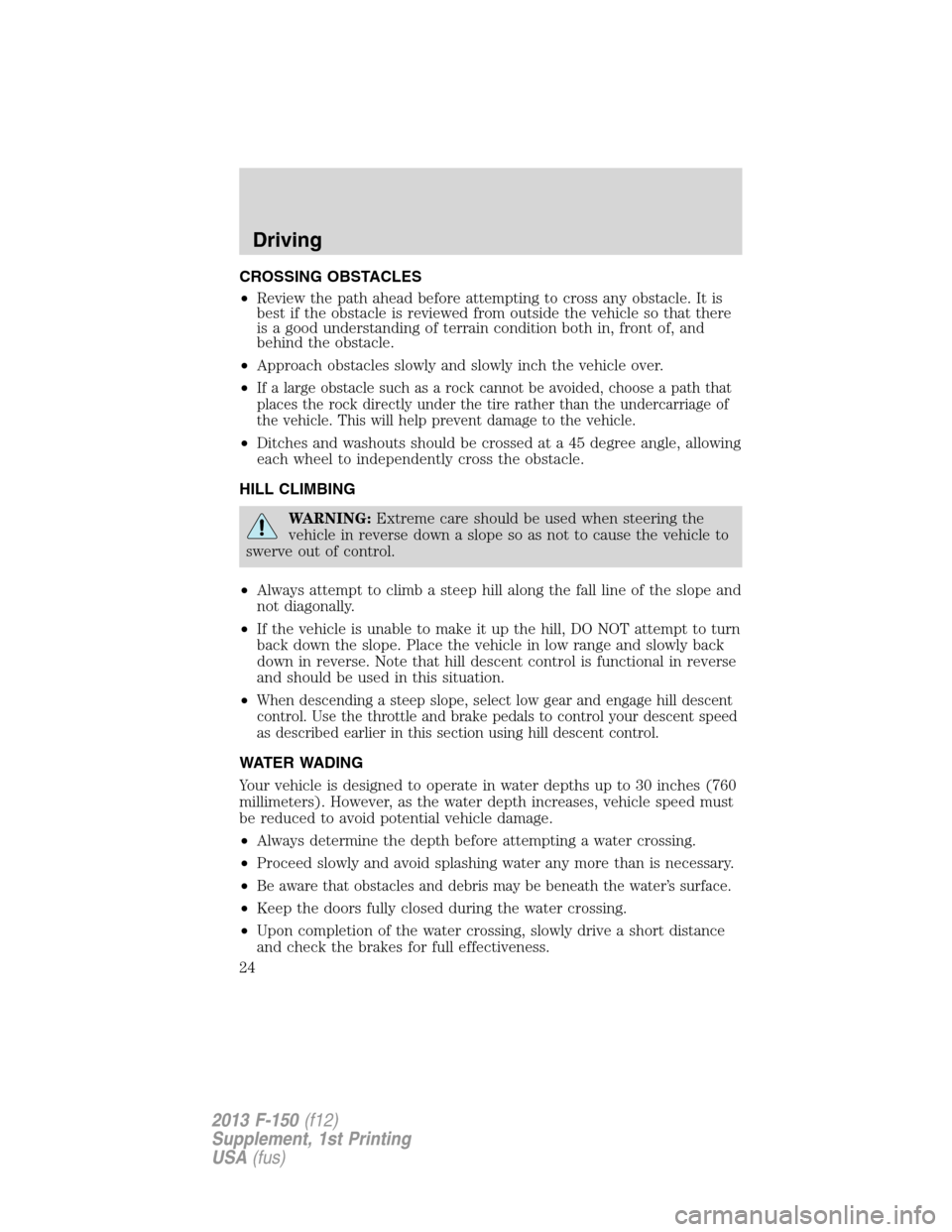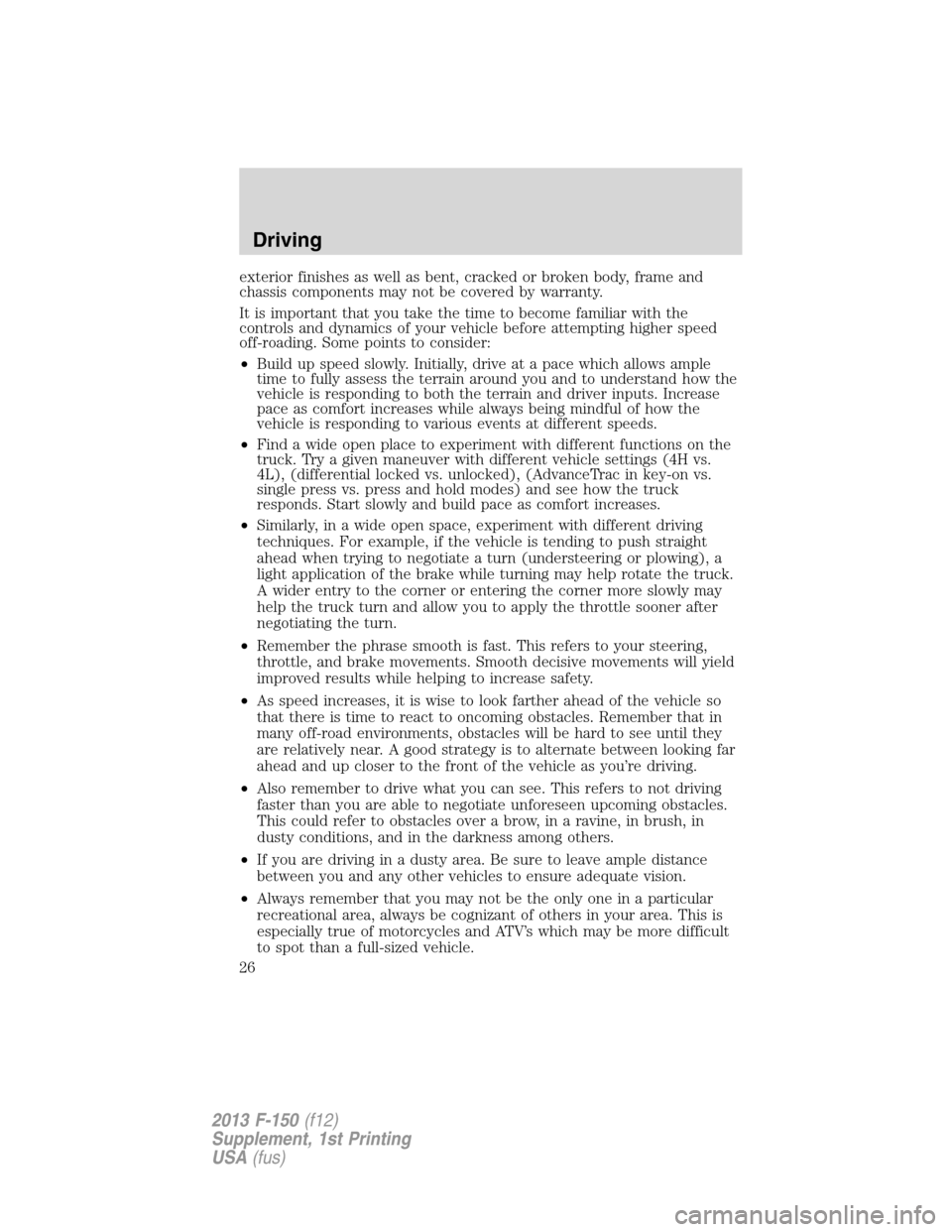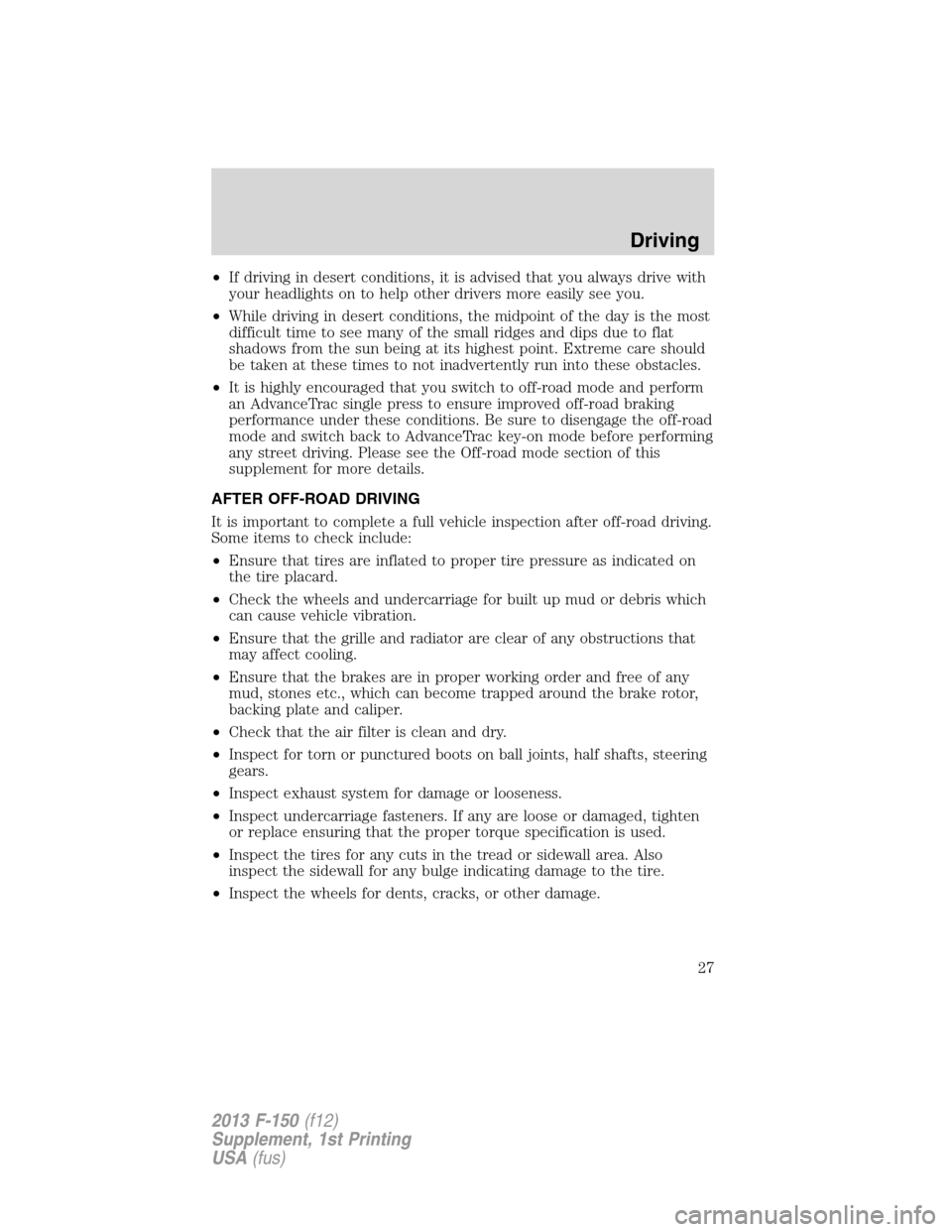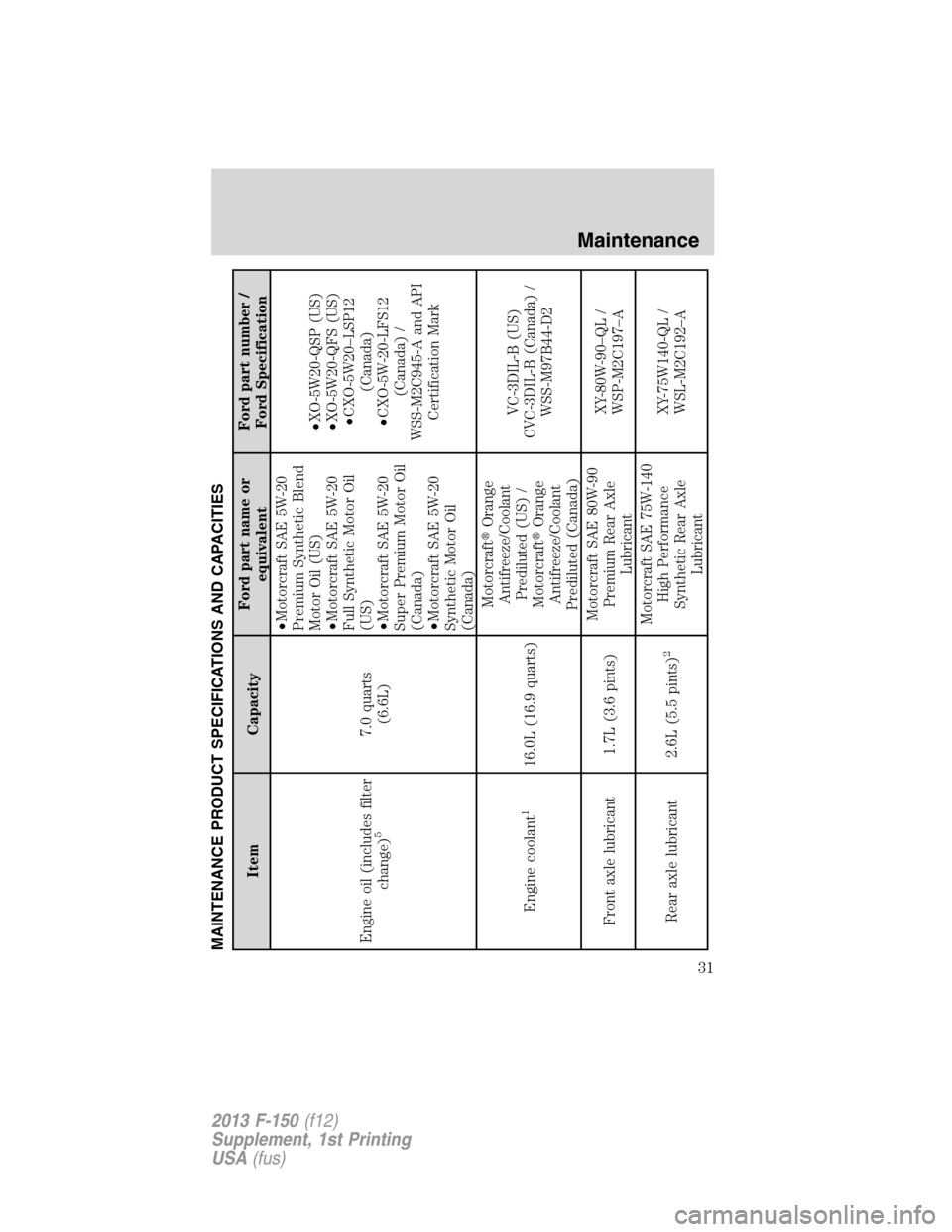Page 25 of 39

CROSSING OBSTACLES
•Review the path ahead before attempting to cross any obstacle. It is
best if the obstacle is reviewed from outside the vehicle so that there
is a good understanding of terrain condition both in, front of, and
behind the obstacle.
•Approach obstacles slowly and slowly inch the vehicle over.
•
If a large obstacle such as a rock cannot be avoided, choose a path that
places the rock directly under the tire rather than the undercarriage of
the vehicle. This will help prevent damage to the vehicle.
•Ditches and washouts should be crossed at a 45 degree angle, allowing
each wheel to independently cross the obstacle.
HILL CLIMBING
WARNING:Extreme care should be used when steering the
vehicle in reverse down a slope so as not to cause the vehicle to
swerve out of control.
•Always attempt to climb a steep hill along the fall line of the slope and
not diagonally.
•If the vehicle is unable to make it up the hill, DO NOT attempt to turn
back down the slope. Place the vehicle in low range and slowly back
down in reverse. Note that hill descent control is functional in reverse
and should be used in this situation.
•
When descending a steep slope, select low gear and engage hill descent
control. Use the throttle and brake pedals to control your descent speed
as described earlier in this section using hill descent control.
WATER WADING
Your vehicle is designed to operate in water depths up to 30 inches (760
millimeters). However, as the water depth increases, vehicle speed must
be reduced to avoid potential vehicle damage.
•Always determine the depth before attempting a water crossing.
•Proceed slowly and avoid splashing water any more than is necessary.
•
Be aware that obstacles and debris may be beneath the water’s surface.
•Keep the doors fully closed during the water crossing.
•Upon completion of the water crossing, slowly drive a short distance
and check the brakes for full effectiveness.
Driving
24
2013 F-150(f12)
Supplement, 1st Printing
USA(fus)
Page 26 of 39

Refer to chart below for the maximum allowable speeds when driving
through water.
Note:Failure to follow the recommended speeds may result in vehicle
damage.
Water Depth Maximum Allowable
Vehicle Speed
6 inches (150 millimeters) 40 mph (65 km/h)
8 inches (200 millimeters) 31 mph (50 km/h)
10 inches (250 millimeters) 19 mph (30 km/h)
12 inches (300 millimeters) 8 mph (12 km/h)
18 to 30 inches
(450 millimeters to 760 millimeters)4 mph (7 km/h)
Reverse – up to 30 inches (760 millimeters) Less than 6 mph (10 km/h)
HIGH SPEED OFF-ROADING
The off-road driving discussed thus far has focused on the type of events
typically encountered during slow speed off-road driving conditions. The
F-150 SVT Raptor provides excellent performance in a full size pick-up
truck during these slower speed conditions, but truly excels at higher
speed baja style off-road driving. High speed off-roading presents a
unique challenge, but extra care and caution should be taken before
engaging in this type of driving. If you plan on using the truck for severe,
high speed off-road use, the following is recommended:
•Equip your truck with the safety equipment used for the Stock-Full
Class as defined in the rule books for the Best in the Desert Racing
(www.bitd.com) and SCORE International Off-Road Racing
(www.score-international.com).
•Use personal safety equipment including a SNELL SA certified helmet
and approved neck restraint device.
•Before venturing off-road in unfamiliar areas at high speeds, do a low
speed reconnaissance run (“prerun”) to become aware of any
obstacles that you will encounter.
Ford SVT has engineered your F-150 Raptor for off-road use beyond
what is normal for a F-150. However, it can incur damage if driven
beyond its capabilities. Skid plates, shock guards and running boards
were designed to help limit damage to vital components and exterior
finishes, but cannot prevent all damage if driven in extreme off-road
conditions. Damage to skid plates, shock guards, running boards and
Driving
25
2013 F-150(f12)
Supplement, 1st Printing
USA(fus)
Page 27 of 39

exterior finishes as well as bent, cracked or broken body, frame and
chassis components may not be covered by warranty.
It is important that you take the time to become familiar with the
controls and dynamics of your vehicle before attempting higher speed
off-roading. Some points to consider:
•Build up speed slowly. Initially, drive at a pace which allows ample
time to fully assess the terrain around you and to understand how the
vehicle is responding to both the terrain and driver inputs. Increase
pace as comfort increases while always being mindful of how the
vehicle is responding to various events at different speeds.
•Find a wide open place to experiment with different functions on the
truck. Try a given maneuver with different vehicle settings (4H vs.
4L), (differential locked vs. unlocked), (AdvanceTrac in key-on vs.
single press vs. press and hold modes) and see how the truck
responds. Start slowly and build pace as comfort increases.
•Similarly, in a wide open space, experiment with different driving
techniques. For example, if the vehicle is tending to push straight
ahead when trying to negotiate a turn (understeering or plowing), a
light application of the brake while turning may help rotate the truck.
A wider entry to the corner or entering the corner more slowly may
help the truck turn and allow you to apply the throttle sooner after
negotiating the turn.
•Remember the phrase smooth is fast. This refers to your steering,
throttle, and brake movements. Smooth decisive movements will yield
improved results while helping to increase safety.
•As speed increases, it is wise to look farther ahead of the vehicle so
that there is time to react to oncoming obstacles. Remember that in
many off-road environments, obstacles will be hard to see until they
are relatively near. A good strategy is to alternate between looking far
ahead and up closer to the front of the vehicle as you’re driving.
•Also remember to drive what you can see. This refers to not driving
faster than you are able to negotiate unforeseen upcoming obstacles.
This could refer to obstacles over a brow, in a ravine, in brush, in
dusty conditions, and in the darkness among others.
•If you are driving in a dusty area. Be sure to leave ample distance
between you and any other vehicles to ensure adequate vision.
•Always remember that you may not be the only one in a particular
recreational area, always be cognizant of others in your area. This is
especially true of motorcycles and ATV’s which may be more difficult
to spot than a full-sized vehicle.
Driving
26
2013 F-150(f12)
Supplement, 1st Printing
USA(fus)
Page 28 of 39

•If driving in desert conditions, it is advised that you always drive with
your headlights on to help other drivers more easily see you.
•While driving in desert conditions, the midpoint of the day is the most
difficult time to see many of the small ridges and dips due to flat
shadows from the sun being at its highest point. Extreme care should
be taken at these times to not inadvertently run into these obstacles.
•It is highly encouraged that you switch to off-road mode and perform
an AdvanceTrac single press to ensure improved off-road braking
performance under these conditions. Be sure to disengage the off-road
mode and switch back to AdvanceTrac key-on mode before performing
any street driving. Please see the Off-road mode section of this
supplement for more details.
AFTER OFF-ROAD DRIVING
It is important to complete a full vehicle inspection after off-road driving.
Some items to check include:
•Ensure that tires are inflated to proper tire pressure as indicated on
the tire placard.
•Check the wheels and undercarriage for built up mud or debris which
can cause vehicle vibration.
•Ensure that the grille and radiator are clear of any obstructions that
may affect cooling.
•Ensure that the brakes are in proper working order and free of any
mud, stones etc., which can become trapped around the brake rotor,
backing plate and caliper.
•Check that the air filter is clean and dry.
•Inspect for torn or punctured boots on ball joints, half shafts, steering
gears.
•Inspect exhaust system for damage or looseness.
•Inspect undercarriage fasteners. If any are loose or damaged, tighten
or replace ensuring that the proper torque specification is used.
•Inspect the tires for any cuts in the tread or sidewall area. Also
inspect the sidewall for any bulge indicating damage to the tire.
•Inspect the wheels for dents, cracks, or other damage.
Driving
27
2013 F-150(f12)
Supplement, 1st Printing
USA(fus)
Page 29 of 39
WRECKER TOWING
If you need to have your vehicle towed, contact your roadside assistance
center or a professional towing service.
It is required that your vehicle be towed with flatbed equipment. When
towing with a flatbed, 4x4 blocks must be used when loading and
unloading your vehicle. Do not tow with a slingbelt. Ford Motor Company
has not approved a slingbelt towing procedure.
Note:If the vehicle is towed by other means or incorrectly, vehicle
damage may occur.
Roadside Emergencies
28
2013 F-150(f12)
Supplement, 1st Printing
USA(fus)
Page 30 of 39
WASHING YOUR F-150 SVT RAPTOR
Do not drive your vehicle through an automated, commercial car wash
due to the vehicle’s tire width and track. Wash your vehicle by hand, or
by using a touchless commercial wash with no mechanical tracks on the
floor. Do not use a commercial or high pressure wand on the bed side
graphic surface or graphics edges.
Cleaning
29
2013 F-150(f12)
Supplement, 1st Printing
USA(fus)
Page 31 of 39
MOTORCRAFT PART NUMBERS
Component 6.2L V8 engine
Air filter element FA-1883
Battery BTX-59 or BTX-65-650
1
Oil filter FL-820S
Spark plugs2
1
Heavy-duty battery, if equipped
2For spark plug replacement, see your authorized dealer. Refer to the
Scheduled Maintenance information for the appropriate intervals for
changing the spark plugs.
Replace the spark plugs with ones that meet Ford material and design
specifications for your vehicle, such as Motorcraft or equivalent
replacement parts. The customer warranty may be void for any damage
to the engine if such spark plugs are not used.
Maintenance
30
2013 F-150(f12)
Supplement, 1st Printing
USA(fus)
Page 32 of 39

MAINTENANCE PRODUCT SPECIFICATIONS AND CAPACITIES
Item CapacityFord part name or
equivalentFord part number /
Ford Specification
Engine oil (includes filter
change)
5
7.0 quarts
(6.6L)•Motorcraft SAE 5W-20
Premium Synthetic Blend
Motor Oil (US)
•Motorcraft SAE 5W-20
Full Synthetic Motor Oil
(US)
•Motorcraft SAE 5W-20
Super Premium Motor Oil
(Canada)
•Motorcraft SAE 5W-20
Synthetic Motor Oil
(Canada)•XO-5W20-QSP (US)
•XO-5W20-QFS (US)
•CXO-5W20–LSP12
(Canada)
•CXO-5W-20-LFS12
(Canada) /
WSS-M2C945-A and API
Certification Mark
Engine coolant
1
16.0L (16.9 quarts)Motorcraft�Orange
Antifreeze/Coolant
Prediluted (US) /
Motorcraft�Orange
Antifreeze/Coolant
Prediluted (Canada)VC-3DIL-B (US)
CVC-3DIL-B (Canada) /
WSS-M97B44-D2
Front axle lubricant 1.7L (3.6 pints)Motorcraft SAE 80W-90
Premium Rear Axle
LubricantXY-80W-90–QL /
WSP-M2C197–A
Rear axle lubricant 2.6L (5.5 pints)
2
Motorcraft SAE 75W-140
High Performance
Synthetic Rear Axle
LubricantXY-75W140-QL /
WSL-M2C192–A
Maintenance
31
2013 F-150(f12)
Supplement, 1st Printing
USA(fus)